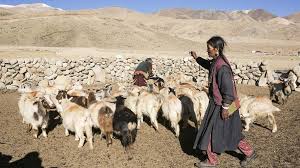Changpa Tribe:

Climate activist Sonam Wangchuk and Leh Apex Body (LAB) decided to call off the Pashmina border march aimed at highlighting the plight of the Changpa nomadic tribes.
- The Changpa, or Champa, are semi-nomadic people found mainly in the Changtang plateau of southeastern Ladakh.
- They share linguistic and cultural affinities with Tibetans.
- All Changpa families profess Tibetan Buddhism as their religion.
- They are high-altitude pastoralists, raising mainly yaks and goats.
- They can be identified by their conical yak-skin tents called reboo.
- Each reboo invariably accommodates the family deity, and a picture of their spiritual head, in most cases, the Dalai Lama.
- The Changpa who live nomadic lives are known as Phalpa, while those who have settled down in fixed locations are called Fangpa.
- For many Changpas, rearing of animals and consuming and selling their produce (milk and its products, hair, and meat) is the only means of livelihood.
- They rear the highly pedigreed and prized Changra goats (Capra Hircus) that yield the rare Pashmina (Cashmere) fibre. It is the finest fibre of all goat hair.
- Their Buddhist belief does not allow them to kill animals for meat. It is only when animals die a natural death that the carcasses can be used for meat and hide, which the Changpas use to line their huts and make garments.




